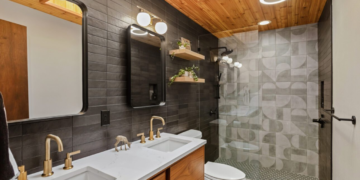Let’s think this through before we get wowed by the brochure.
Windows aren’t just holes in the wall with glass in them. Done right, they’re a system—part of the building envelope, part of your heating and cooling equation, part of how the place feels to live in every day. And when it comes to aluminium SMART windows that promise slimline looks and solar protection, you better make sure what you’re buying is more than just a pretty face.
I’ve framed thousands of windows in everything from budget remodels to high-performance custom builds. And let me tell you: the best ones like Hadleigh Glass windows are built with intention, not marketing lingo. So before you sign off on that sleek brochure with the sunset view and the tinted glass, let’s walk through the fundamentals.
1.What’s an Aluminium SMART Window, Anyway?
Let’s break it down.
Aluminium gives you slim profiles and structural strength. Smart means it reacts to something—maybe heat, maybe light, maybe a control system you manage from your phone. And solar protection means it keeps the sun’s heat and glare out while still letting in light and preserving the view.
A good aluminium SMART window is a five-part system:
- Frame (ideally thermally broken aluminium)
- Glazing (double or triple pane, often low-emissivity or coated)
- Smart glass tech (like electrochromic tinting or SPD)
- Seals and gaskets (to maintain airtightness)
- Controls (sensors, apps, automation)
The point is, if one part’s weak, the whole system fails. So don’t get distracted by how thin the frame looks if the rest of the window can’t keep up.
2.Why Go Slimline?
There’s nothing fancy here—just fundamentals.
Slimline frames mean more glass, more daylight, better views, and a cleaner aesthetic. Aluminium is the material of choice here because it’s strong enough to support large panes without bulky sashes. That’s why architects love it. But it’s also a conductor of heat and cold. If you’re putting in aluminium windows in a place that sees snow—or desert sun—you’d better ask about thermal breaks.
A thermally broken aluminium frame has a non-metal core (often resin or polyamide) that interrupts the path of heat transfer. It keeps the inside warm when it’s cold out and cool when the sun’s baking the south side of the house. Without that break, you’re installing a radiator into your wall.
3.Solar Protection Isn’t Optional Anymore
You can’t fool sunlight.
We’re past the days when you could put in big panes of clear glass and call it a feature. In today’s high-performance builds—and even in modest homes in hot climates—solar heat gain is a serious problem. Too much heat through windows means more money spent cooling the house. Glare is no picnic either.
Solar protection comes from coatings (Low-E, spectrally selective), from the number of panes, and sometimes from dynamic glass that tints automatically when the sun hits it. The best systems balance light transmission and heat control.
There’s a metric for that: SHGC—solar heat gain coefficient. A lower SHGC means less solar energy makes it through. For reference, clear double-pane glass might have an SHGC of 0.70. High-performance solar control glass can get down to 0.25 or lower. That matters when you’ve got west-facing walls and Tahoe sun bouncing off snow or lake water.
4.What Makes a Window “Smart”?
This is where it usually goes wrong.
There’s a big difference between a window with a motorized blind and true smart glass. True SMART windows change the behavior of the glass itself—no moving parts, no dust-collecting shades. The two big players here are electrochromic and SPD (suspended particle device) glazing.
Electrochromic glass, like SageGlass or Halio, uses a small voltage to trigger molecules in the glass to shift and block light. It’s slow—takes a few minutes—but energy-efficient and fully controllable via app, voice, or automated schedule.
SPD glass responds faster—within seconds—but needs constant power to stay tinted. It’s more expensive and often used in commercial or high-end residential.
Smart doesn’t just mean tech. A good smart window integrates with your home’s energy management system. That means automated responses to time of day, indoor temperature, occupancy, even weather forecasts. Done right, it reduces HVAC demand and boosts comfort. Done wrong, it’s just an expensive toy.
5.Installation: The Step That Makes or Breaks It
Fast is slow if you have to redo it.
You can spend all the money in the world on top-tier windows, but if they’re installed like a weekend DIY project, you’ve wasted your investment. The install has to maintain the airtight envelope. That means flashing, sealing, and insulating around the window. And it means the system wiring—especially for SMART features—needs to be clean, safe, and accessible.
Talk to your installer. Ask if they’ve worked with this specific system. Ask how they’ll run the controls. Ask about commissioning and calibration.
And don’t forget: if you’re building high-performance walls (like double-stud or ICF), make sure the window detailing matches. Thermal bridging doesn’t care how expensive the glass is.
6.Real-World Applications: Where These Shine
In my experience, aluminium SMART windows make the most sense in two situations:
- Modern homes with large glazed openings, especially in view homes or high-sun environments.
- Buildings where energy efficiency, passive solar control, and automation are key—like passive houses or off-grid builds.
I’ve seen passive solar homes in Colorado cut cooling costs by 30% just by using dynamic glass on west-facing façades. I’ve seen off-grid cabins in Australia use photochromic windows to limit interior overheating without pulling power from the system. And I’ve seen commercial buildings reduce glare complaints and HVAC load just by automating their tinting windows in sync with the sun.
But don’t let that fool you into thinking it’s plug-and-play. These systems require forethought. Design first, buy later.
7.Cost and Consideration
There are no magic bullets. Everything costs: time, money, complexity.
Aluminium SMART windows are not cheap. Basic thermally broken aluminium with solar control double glazing might run $100–150 per square foot. Add SMART tinting, and you’re easily pushing $200–300+ per square foot, depending on size and integration.
But value isn’t about up-front cost. It’s about long-term performance. Reduced cooling bills. Less glare. A view you can actually enjoy all year.
Respect the customer’s money. Build it like you’d live in it.
8.Final Thoughts: The System Is the Product
Here’s what I want you to remember:
Don’t spec a window just because the showroom demo looked good. Think about how it performs at 2pm in July. Think about who’s going to maintain the control system. Think about condensation, insulation, and what it’s going to be like to clean that triple-glazed glass 15 feet off the ground.
Aluminium SMART windows can be a beautiful, functional, high-performance solution—but only if you treat them like the complex systems they are. Honor the details. Respect the envelope. And don’t buy more tech than you’ll actually use.
Craftsmanship isn’t just about what you build—it’s about how you plan. Build with foresight. Think like someone who’ll live there for the next 30 years.
Because when you do it right, good windows don’t just frame the view—they frame the future.













